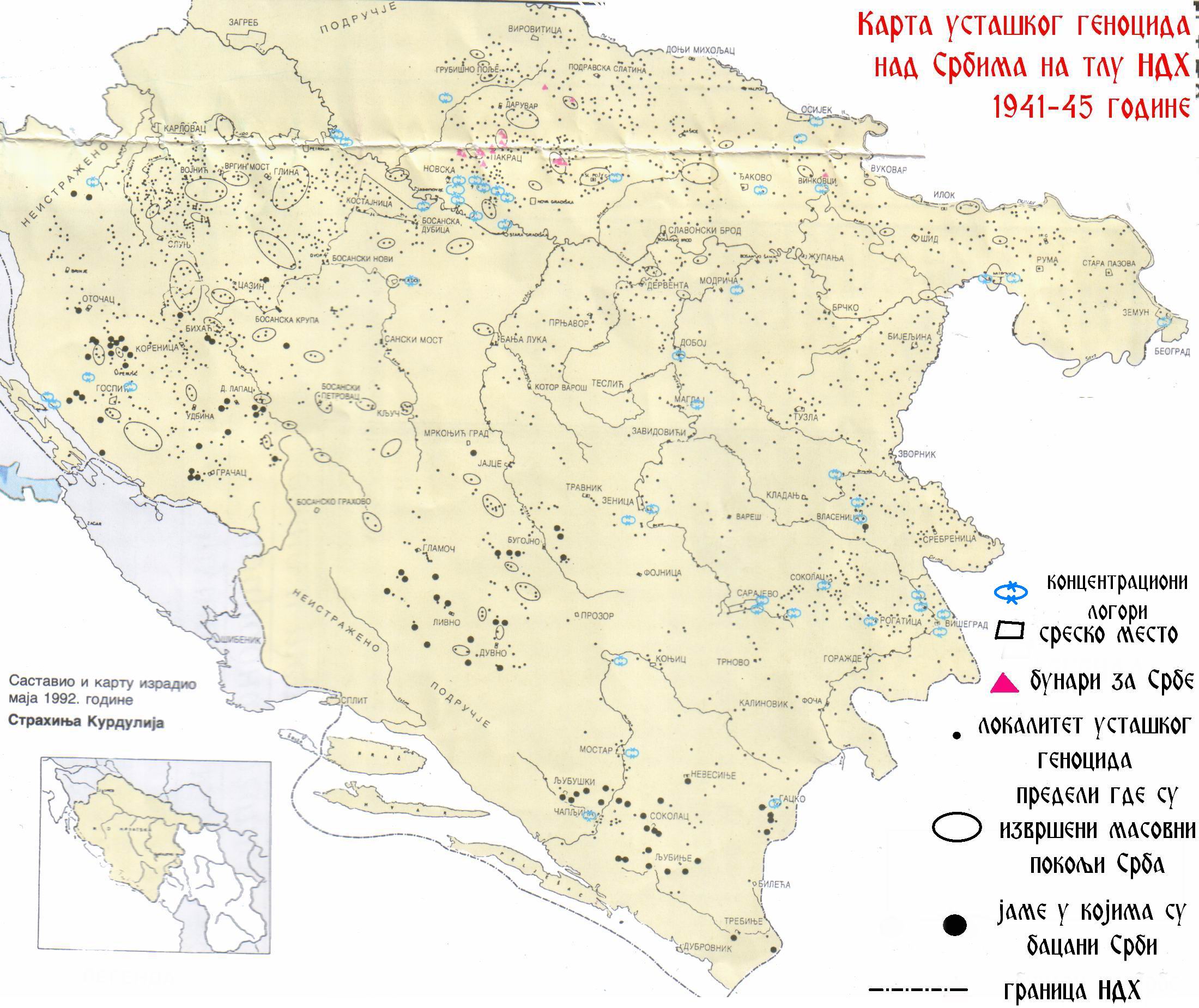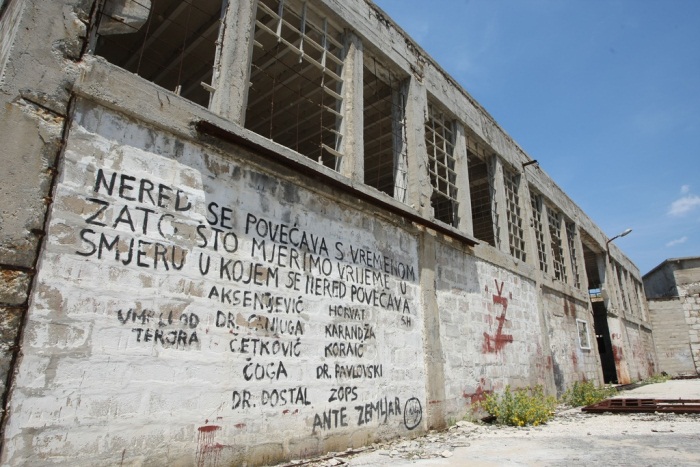| |
About us
Internet portal www.ZlociniNadSrbima.com is a non-political and non-profitable site aimed at preserving and spreading the truth about the suffering of Serbian people in those areas of Balkan peninsula where they have been living for decades, but which they were being expelled from during the 20th-century and early-21st century wars, leading to the destruction of their property, and orthodox churches, in other words, evidence on life and cultural identity of Serbs in those areas.
Our mission and vision do not include the spread of hate, nor call for new wars. On the contrary, we strive to keep the memory of the suffering of Serbian people in recent times. Furthermore, we believe that the war criminals who are still alive and left unpunished, must be brought to justice, persecuted and properly punished, so that the crimes are not committed again.
This website contains a lot of documents, articles, recordings, authentic testimonies of people who survived torture and execution. For these reasons, it should not be visited by sensitive persons and children under the age of 16. We wish that you, as our visitors, contributed to the operation of this site by advice, useful comments, and appropriate materials which you think could improve the site. If we choose not to share the truth which we know, it is the same as we want to conceal it. Concealing the crime is the crime itself. We refuse to turn our heads away from the suffering, and extermination that Serbian people faced during the wars.
During the First World War (1914-1918) when the Austro-Hungarian empire attacked the Kingdom of Serbia, great suffering of Serbian people began, at first in the region of Macva, and then in the battles. In November 1915, Austro-Hungary was supported by Germany with its allies, leading to a greater attack against Serbia. This forced the army and people to retreat to the South, through Albanian mountains, to reach the ports of Skadar and Drac, and later the island Corfu. Those who remained in Serbia, also went through great suffering since the Bulgarian army committed terrific crimes. Moreover, the Government in Vienna ordered the establishment of at least 50
internment camps in the territory of Austro-Hungary. Some of them were Dоbој, Heinrichsgrün (Jindrihovice), Оmоluc, Аshаh, Brоumоv, Nеckеnmаrkt, Nadjimеdеr, Frauenkirchen, Nеzidеr, Аrаd, Теrеzin,
Mauthausen...
 |  |
| Serbian soldiers on battlefield | The Organization Srbski Svetionik in visit to the memorial
in Thessaloniki devoted to Serbian soldiers of WW1 |
In addition, the Bulgarian government established 22 internment camps in Bulgaria such as Slivеn, Plоvdiv, Lоm, Hаskоvо, Kаrlоvо, Vаrnа, Dоbrič, Јаmbоl, Sоfiа. The crimes committed by Austro-Hungary and its allies were recorded by Serbian great friend Archibald Riess from Switzerland. With the breakthrough of Salonika front in 1918, the Army of the Kingdom of Serbia supported by its allies, liberated their fatherland after which Serbia entered the joint state with Croatia and Slovenia. In World War I at least two million Serbs died, with 1,254,000 from the territory of the Kingdom of Serbia, and 650,000 from the areas of Dalmatia, Herzegovina, Montenegro, Slavonia, Vojvodina, Bosnia, Banija, Kordun, and Lika.
During the Second World War (1941-1945), Germany and the Vatican helped Ustashe (Croatian clerical-fascistic and terrorist organization) to create the Independent State of Croatia which only by itself killed more than 1,500,000 Serbs. Plans for carrying out the genocide were made before the outbreak of the war, while during the war, Ustashe established internment camps throughout the entire territory under their control. They even established internment camps for children. Not only Serbs, but Jews, Roma people were brought to the camps, and a few politically unsuitable Croats. As for the Muslims, the majority of them chose to obey the leader of Ustashe, Ante Pavelic. After the end of the war, Communist authorities persecuted some of the Ustashe slaughterers, but most of them managed to escape justice with the help of the Vatican through its “Ratlines”.
 |  |
| Map of genocide Indenpendent State of Croatia | Our activists in visit to the memorial 'Drakulic' in Banja Luka
devoted to Serbian victims of WW2 |
WW2 Crimes against Serbs weren’t committed only in the territory of the Independent State of Croatia, but in Eastern Serbia and Vardar Macedonia by Bulgarian soldiers, and in Baranja and Backa by Hungarian fascists. In addition, Albanian gangs in Kosovo and Metohija committed a tremendous number of crimes against everything that had some connections with Serbs and Orthodox Christian faith. The Nazi German soldiers in Serbia implemented genocidal rule “to kill 100 Serbs for 1 killed German”. This was the time when Serbs were ethnically endangered, and when they survived an actual holocaust. In World War 2, two million Serbs lost their lives.
After World War II communist authorities in Yugoslavia killed at least 60,000 Serbs. Executions were organized by its notorious intelligence service. Some estimations go up as high as 100,000 to include monarchists, sympathizers of Stalin and USSR. These people were sent to Goli Otok where the special camp was established for the torture of political prisoners.
The era of the socialist Yugoslavia seen as the time of peace and prosperity, witnessed the strange actions which were organized or concealed by communist authorities, especially with respect to crimes committed against Serbs in Kosovo and Metohija. The cases of Danilo Milicic and Djordje Martinovic from Kosovo who were murdered during the 1980s, remained undisclosed to the public.
 |  |
| The exterior of one of the communist prisons on the Island Goli Otok. | A group of Serbian patriots in visit to the memorial 'Lisiciji Potok' in Belgrade
devoted to Serbian victims of Communist repression |
With the breakdown of the socialist Yugoslavia in 1990-1991, Serbian people faced the threat of repeated genocide. Separatistic forces, first in Slovenia and Croatia, and later in Bosnia, not only aimed at the extermination of Serbs from their republics, but wiping away all traces of their life and cultural identity, as well. They were largely supported by EU and NATO countries which helped Croatia to carry out genocidal actions “The Flash”, and “The Storm” in 1995. These actions were the first and greatest pogroms that happened in Europe after WW2. Consequently, Serbs in Croatia were almost entirely wiped out. As early as 1992, Croatia enacted the law on forgiveness, under which every Croatian participant in the war was pardoned for every crime, in advance.
In Bosnia and Herzegovina, horrific crimes were carried out by Croatian and Muslim police and paramilitary forces, largely in the territory of Herzegovina, and around the cities of Srebrenica and Sarajevo where dozens of Serbian settlements and churches were destroyed. During the ‘90s war, in the territory of Slovenia, Croatia, and Bosnia and Herzegovina, at least war, in the territory of Slovenia, Croatia, and Bosnia and Herzegovina, at least 778 internment camps for the torture of Serbs were established (notwithstanding the age and sex), most notorious of them being Lоrа, Čеlеbići, Silоs, Drеtеlj and Ribаrskа kоlibа.
 |  |
Serbian refugees expelled from Croatia during
the ethnic cleansning 'Storm' | Our activists in visit to the memorial 'Bratunac' in Srebrenica region
devoted to Serbian victims of Bosnian Muslim criminals |
Yet, expulsion of Serbs in Kosovo and Metohija continued after the peace agreement had been signed, reaching its peak in March 2004, when Albanians from Kosovo carried out extensive pogrom of Serbs. The International Criminal Court in Hague and the Persecutor’s Offices in Slovenia, Croatia, Bosnia and Herzegovina, and so-called “state of Kosovo” deliberately avoid to bring the war criminal to justice although they were provided with enough evidence several years after the war. They even go so far to justify their actions with “obsolescence of crimes”.
The evil and injustice that happened to Serbian people is the primary reason for the operation of this website as a reminder to those who want to minimalize and conceal these crimes with the argument that the bright future will come, if we choose to forget.
"For the dead and the living, we must bear witness!"
- Elie Wiesel, Holocaust survivor
|
|